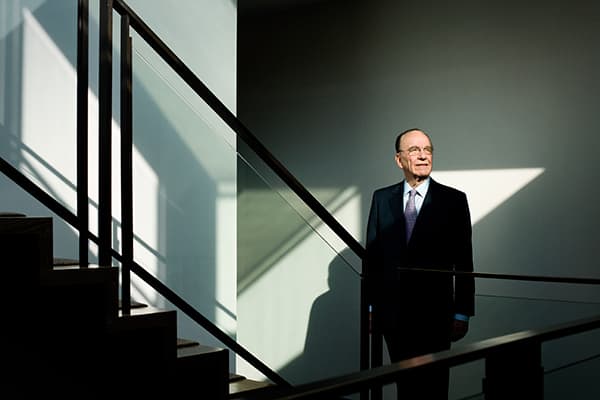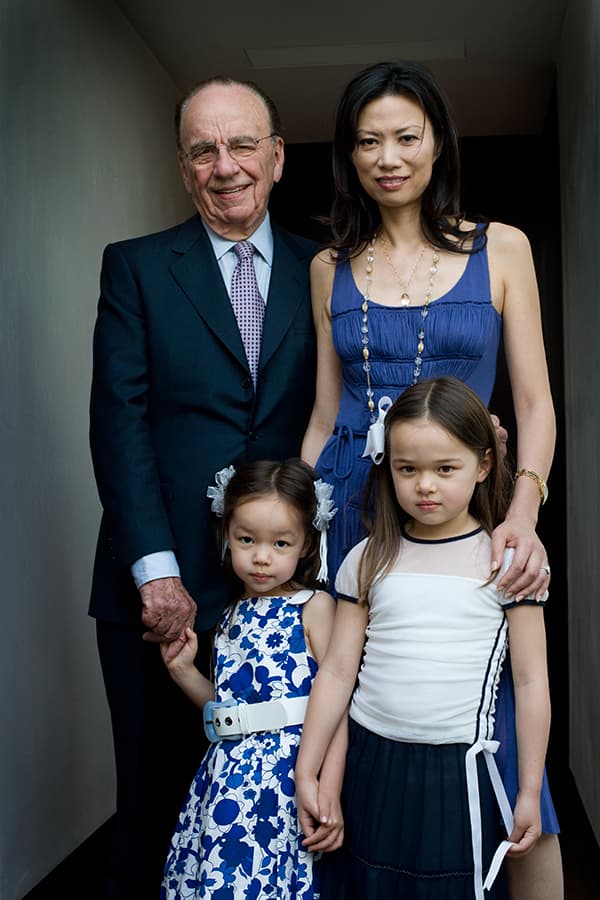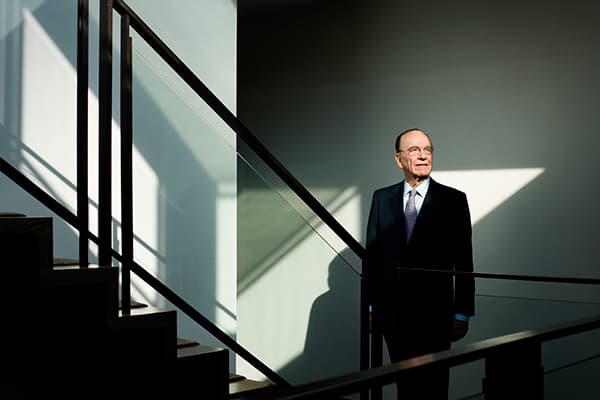
Harry noticed this pool of light spilling onto a wall of Murdoch’s home and decided to create a portrait containing striking graphic elements
In June 2007, I was commissioned to photograph Rupert Murdoch, the billionaire founder, chairman and CEO of international media company News Corporation. The shoot was for the front cover of Time magazine’s global edition. For a portrait commission, you don’t get much better than that.
I was invited to photograph him at his house in St James’s, London. It was an extraordinary building, a real billionaire’s house. It backed on to St James’s Park and he’d had it converted into a series of modernist apartments in which each floor was allocated to one of his children. At the top of the house, he had a retractable glass roof which opened at the press of a button. It was like something out of Dr No.
Murdoch was then 76 years old and married to his third wife, Wendi Deng. As well as his four older children from previous marriages, he had two young daughters, Grace and Chloe, who I met when I was there.

A family shot of Rupert Murdoch in 2007 with his wife Wendi and children Chloe and Grace
Meeting Murdoch
I knew Murdoch could be unpredictable in front of the camera. I had photographed him in 2006 for his Sky annual company report and was told that the previous year, the photographer had set up a shot but only got one frame before Murdoch stood up and walked off.
My brief this time was simply to shoot a head-and-shoulders portrait, so I arrived at the house equipped with a backdrop. I was let in the house for the appointed time of the shoot, but Murdoch was over an hour and a half late, which gave me plenty of time to get really stressed.
Eventually he arrived. He had his business advisors with him. Being photographed, even for the cover of Time magazine, wasn’t a very important part of his agenda and he was running his business even while I was shooting his portrait.
As with the previous time I’d met him, I found him a detached and distracted person, but as sharp as a tack. I mentioned to him that I had recently photographed Margaret Thatcher. As they were both part of a powerful elite I assumed they were friends, but his only comment was, ‘She’s gone a bit gaga, hasn’t she?’
Getting the shot
I quickly did the head shot, which was very simply shot with one-directional lighting against the backdrop. That was all Time needed, but I also wanted to take the opportunity to shoot something different. I’m always looking for a picture I hadn’t anticipated getting, one that gives the photo a time and a place, rather than simply a head shot against a backdrop. It’s nice to get something environmental that will stand the test of time and make the picture intriguing.
I decided the best way to do this was to get him out onto the roof of his house and do something with daylight. I had previously photographed his son James, and daughter Elisabeth, and handed Murdoch prints of them both. This gave me more time and helped to create enough good feeling for me to finesse him onto the stairs and up to the roof.
As we were walking up I noticed there was really nice light coming down on the staircase. Often when I’m shooting a portrait I find a pool of light and a composition that has a graphic tension and then just put someone into that space. In this case, I saw the potential for the picture on the staircase and said to him, ‘Hang on, hold that.’ Then I quickly took a few shots with my Canon EOS 1DS Mark II, handheld. I exposed for the highlights so it’s quite dark and moody.
Perfect timing
This scene, with its diagonal lines and areas of light and shade, would have made an interesting abstract composition even without a person in it. Murdoch was standing in direct sunlight, but it was taken just before 5pm, so the light was a bit softer. This was lucky, because if it had been midday the sunlight would have been too intense to take this shot.
All the frames shot on the stairs show him looking to his left because all the graphics in that picture indicate that he has to look that way. Being a good photographer is about noticing these things when you’re in a really stressful situation, rather than noticing them later when you’re downloading the pictures at home. You have to retain that kernel of calm in your mind so you can coldly and dispassionately look through the camera and make those small but vital adjustments to someone’s position, stance or expression.
At the end of the shoot, which took about 15 minutes in total, I asked Wendi if we could get the kids together and shoot a family portrait.
Time only used the head shot, but the picture editor would have seen all the others. Getting something above and beyond what I was expected to get on a shoot creates a good impression of me as a photographer. And nine years later, the picture of Murdoch on the stairs is still one I’m still incredibly proud to have in my portfolio of work.
As told to David Clark
Harry Borden
Harry is one of the UK’s finest portrait photographers and his work has been widely published. He has won prizes at the World Press Photo awards (1997 and 1999) and in 2014 he was awarded an Honorary Fellowship by the Royal Photographic Society. The National Portrait Gallery collection holds over 100 of his images.







